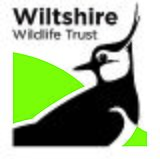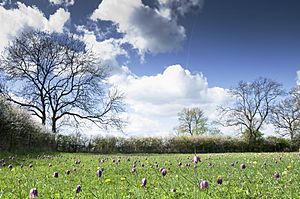Wiltshire Wildlife Trust facts for kids
The Wiltshire Wildlife Trust is a special group that helps nature. It is based in Devizes, England. This group owns and looks after over 40 nature reserves in Wiltshire and Swindon. Nature reserves are protected areas where wild animals and plants can live safely. The Trust also helps people in Wiltshire learn how to live in ways that protect the environment. This is called living a sustainable lifestyle.
The Wiltshire Wildlife Trust is one of 46 similar groups across the United Kingdom. Together, these groups are called The Wildlife Trusts. They form the biggest volunteer-run organisation in the UK. Their main goal is to protect wildlife and wild places everywhere, both on land and in the sea.
The Trust shares information in many ways. They have a magazine for their members called Wiltshire Wildlife. They also use social media like Twitter, Instagram, Facebook, and LinkedIn to connect with people.
Contents
History of the Trust
The Wiltshire Wildlife Trust started a long time ago, in 1962. Back then, it was called 'The Wiltshire Trust for Nature Conservation Ltd'. It began with just seven members, each giving £1 a year. The famous writer and bird expert John Buxton helped to create the Trust. Their first meeting had about 160 people and was held in Trowbridge.
Growing and Protecting Nature
The Trust began creating its first nature reserves in 1963. They bought a place called Blackmoor Copse. Within ten years, they owned nine more reserves. They also received their first gift from someone's will. By then, they had grown to 800 members.
When the Trust turned 20, it owned 30 nature reserves and had 2,000 members. In 1989, they held their first big event, the Sarsen Trail & Neolithic Marathon. This event raised £21,500, which helped them buy the Morgan's Hill nature reserve.
New Name and Otter Success
In 1992, for its 30th birthday, the Trust officially changed its name to Wiltshire Wildlife Trust. A few years later, in 1994, they hired their first project officer to help otters. At that time, there were no known otters living in Wiltshire.
Thanks to their hard work, the project was a big success! By 2012, the Trust had three of its reserves featured in a special guide about otters. This showed how well they had helped otters return to the area.
In 2012, the Trust celebrated its 50th year. By then, they owned and managed 37 nature reserves. As of 2022, which was their 60th year, the Trust looks after over 40 nature reserves. This includes three places where they do farming. They also have more than 20,000 members who support their work.
What the Trust Does
The Wiltshire Wildlife Trust runs many different projects. These projects help local people get involved with nature. They also help people understand and love the natural world. Here are some of the things they do:
- Action for Insects: This project works to increase the number of different insects on their nature reserves.
- Bay Meadows: They are creating a safe place for nature in Marlborough.
- Braydon Forest Marsh Fritillary Project: This project helps the marsh fritillary butterfly, which is a special type of butterfly.
- Building Bridges: This program helps people in Swindon and Wiltshire. It helps them learn new skills, get an education, and find jobs.
- Care Farms: Lakeside and The Willows Care Farms offer special education and work experiences. These are for children, young people, and adults with individual needs.
- Green Living: This project helps people learn how to live in ways that are good for the environment.
- Swindon Forest Meadows: This is a joint project with Swindon Borough Council. They are working together to bring back wildflower meadows.
- Wild Landscapes: This team creates green spaces for both wildlife and people to enjoy.
- Well-being Programme: This program helps people who are feeling stressed or sad. It uses nature to help them feel better.
- Unaccompanied Asylum Seeking Children: This project supports children who have come to the UK alone.
- Protecting Wiltshire's Rivers: Wiltshire has important chalk streams, like the Salisbury Avon.
- Wessex Chalk Streams Project: This project fixes parts of the River Avon and its smaller rivers. These parts were changed by digging and straightening. The project makes the river flow naturally again. It creates bends and rocky areas. This helps animals like the European otter and European water vole.
- Source to Sea and Wiltshire Invasive Species projects: These projects find and remove harmful plants that are not native to the area. Examples include Himalayan balsam and Japanese knotweed. These plants can damage local ecosystems.
Wiltshire has many military families. The Trust has programs that help these families get outside and connect with nature. They also work with the charity Help for Heroes. They help injured service personnel recover by doing conservation tasks at Tedworth House.
Nature Reserves to Explore
The Trust owns and manages over 40 nature reserves across Wiltshire. These include groups of several reserves that are close together. Many of these places are also known as Sites of Special Scientific Interest (SSSIs). This means they are very important for their wildlife or geology.
Here are some of the special nature reserves:
- Clattinger Farm
- Cloatley Manor Farm Meadows
- Clout's Wood
- Cockey Down
- Distillery Farm Meadows
- Emmett Hill Meadows
- Ham Hill
- Homington and Coombe Bissett Downs
- Jones's Mill
- Landford Bog
- Morgan's Hill
- Ravensroost Wood
- Stoke Common Meadows
- Upper Waterhay Meadow
In 2013, the Trust's Clattinger Farm nature reserve was chosen as one of the first "Coronation Meadows." This was to celebrate the 60th anniversary of The Queen's coronation.
Living Landscapes Project
The Trust is part of a bigger national project called "Living Landscapes." This project aims to bring back, create new, and connect natural areas across England. It helps wildlife move more freely between different protected sites and the wider countryside.
Other Ways the Trust Helps
The Wiltshire Wildlife Trust offers other services too:
- Weddings: You can even have your wedding at some of their beautiful locations.
- Cafes: The Trust has two cafes. The Kingfisher Cafe is at Langford Lakes. The Dragonfly Cafe is at Lower Moor.
- Venue Hire: You can rent their spaces for events.
- Care Farms: These farms provide special learning and work experiences.
- Forest School Training: They offer training to become a Forest School leader. This teaches people how to help children learn in nature.
- Workplace Wellbeing: They help businesses improve the wellbeing of their employees through nature.
- Chalkhill Environmental Consultants: This is a team that gives advice on environmental projects.
- Wiltshire Wildlife Community Energy (WWCE): This group works on local energy projects that are good for the environment.
- Wiltshire & Swindon Biological Records Centre (WSBRC): This centre is located at the Trust's main office in Devizes. It collects and shares information about wildlife in Wiltshire. This information is available to the public.



